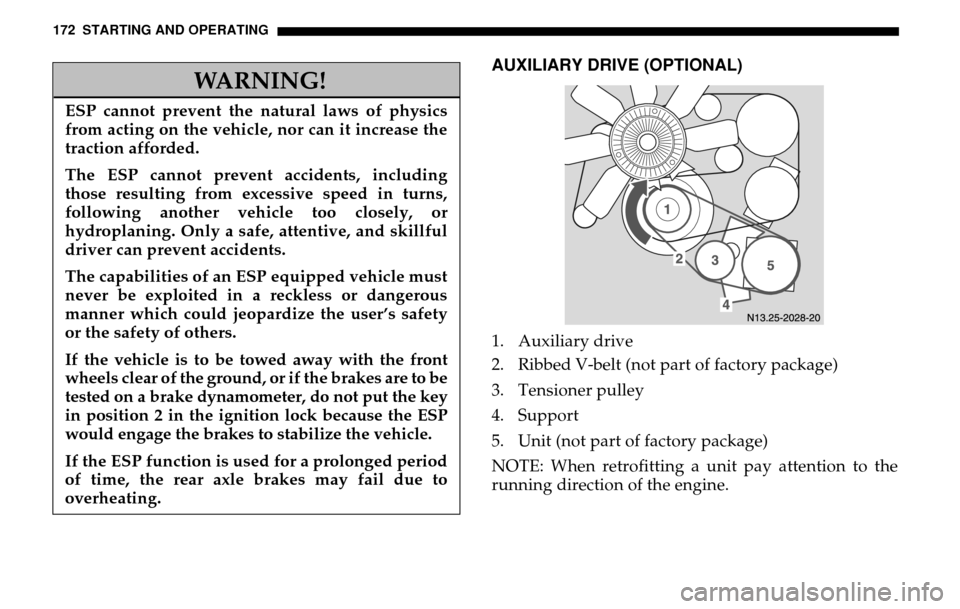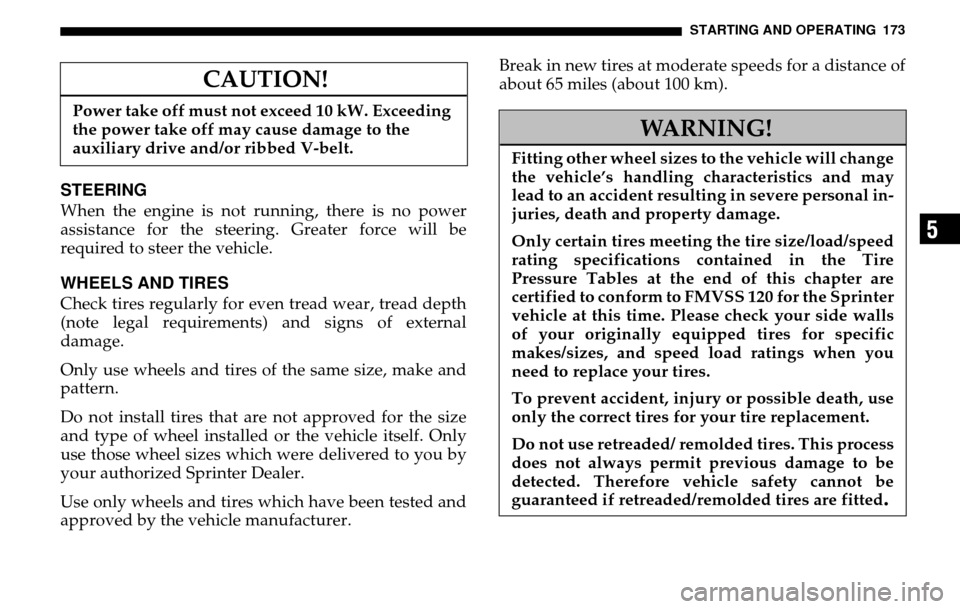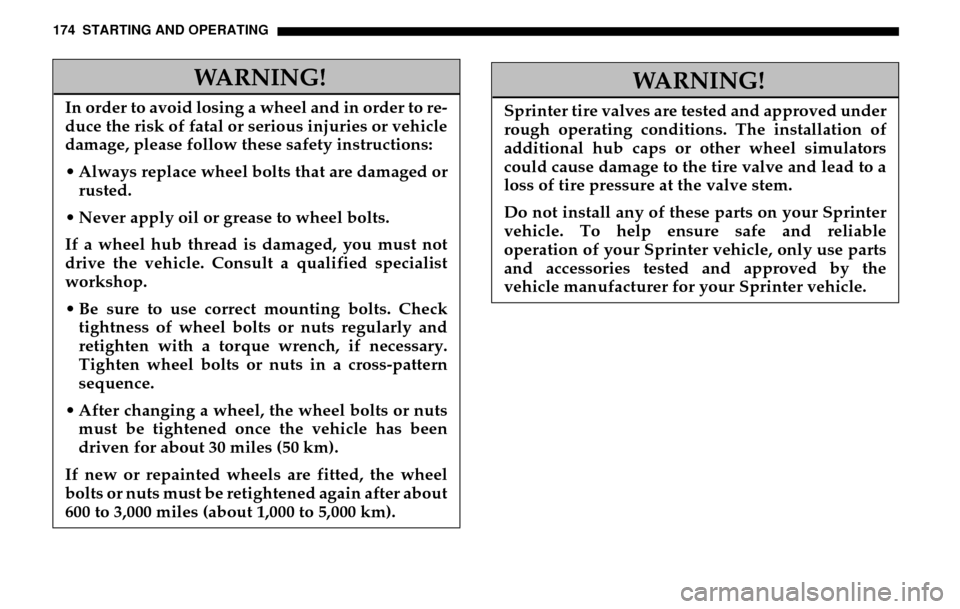DODGE SPRINTER 2005 1.G Owners Manual
Manufacturer: DODGE, Model Year: 2005, Model line: SPRINTER, Model: DODGE SPRINTER 2005 1.GPages: 288, PDF Size: 27.89 MB
Page 171 of 288

STARTING AND OPERATING 171
5
NOTE: If the ABS is malfunctioning or the voltage in
the vehicle’s electrical system drops below 10 volts, the
indicator lamp will also light up in the instrument
cluster and the ESP will be deactivated. The indicator
lamp will go out as soon as the voltage reaches this
level again or the ABS is operational again
– the ESP is
then reactivated.
Electronic Stability Program (ESP) (vehicle type
2500 only)The Electronic Stability Program (ESP) monitors the
vehicle’s traction (force of adhesive friction between
the tires and the road surface) and handling.
The ESP recognizes when a wheel is spinning or if the
vehicle starts to skid. By applying brakes to the
appropriate wheel and by limiting engine output, the
ESP works to stabilize the vehicle. The ESP is especially
useful while driving off and on wet or slippery road
surfaces.
The warning lamp v in the speedometer flashes
when the ESP is engaged, refer also to
"Warning Lamp
Acceleration Skid Control (ASR) and Electronic
Stability Program (ESP)
".
If wheels with tires of a different size than those offered
by an authorized Sprinter Dealer are used, the correct
operation of the ESP cannot be guaranteed.
WARNING!
If the ESP indicator lamp remains on, the
electronic stability program (ESP) is malfunction-
ing. The vehicle stability will no longer be auto-
matically regulated in good time.
The danger that your vehicle breaks into a skid, is
increased in certain driving situations. Drive with
extra caution.
Have the ESP repaired as soon as possible by an
authorized Spinter Dealer.
Page 172 of 288

172 STARTING AND OPERATING
AUXILIARY DRIVE (OPTIONAL)1. Auxiliary drive
2. Ribbed V-belt (not part of factory package)
3. Tensioner pulley
4. Support
5. Unit (not part of factory package)
NOTE: When retrofitting a unit pay attention to the
running direction of the engine.
WARNING!
ESP cannot prevent the natural laws of physics
from acting on the vehicle, nor can it increase the
traction afforded.
The ESP cannot prevent accidents, including
those resulting from excessive speed in turns,
following another vehicle too closely, or
hydroplaning. Only a safe, attentive, and skillful
driver can prevent accidents.
The capabilities of an ESP equipped vehicle must
never be exploited in a reckless or dangerous
manner which could jeopardize the user’s safety
or the safety of others.If the vehicle is to be towed away with the front
wheels clear of the ground, or if the brakes are to be
tested on a brake dynamometer, do not put the key
in position 2 in the ignition lock because the ESP
would engage the brakes to stabilize the vehicle.If the ESP function is used for a prolonged period
of time, the rear axle brakes may fail due to
overheating.
Page 173 of 288

STARTING AND OPERATING 173
5
STEERINGWhen the engine is not running, there is no power
assistance for the steering. Greater force will be
required to steer the vehicle.WHEELS AND TIRESCheck tires regularly for even tread wear, tread depth
(note legal requirements) and signs of external
damage.
Only use wheels and tires of the same size, make and
pattern.
Do not install tires that are not approved for the size
and type of wheel installed or the vehicle itself. Only
use those wheel sizes which were delivered to you by
your authorized Sprinter Dealer.
Use only wheels and tires which have been tested and
approved by the vehicle manufacturer. Break in new tires at moderate speeds for a distance of
about 65 miles (about 100 km).
CAUTION!
Power take off must not exceed 10 kW. Exceeding
the power take off may cause damage to the
auxiliary drive and/or ribbed V-belt.
WARNING!
Fitting other wheel sizes to the vehicle will change
the vehicle’s handling characteristics and may
lead to an accident resulting in severe personal in-
juries, death and property damage.
Only certain tires meeting the tire size/load/speed
rating specifications contained in the Tire
Pressure Tables at the end of this chapter are
certified to conform to FMVSS 120 for the Sprinter
vehicle at this time. Please check your side walls
of your originally equipped tires for specific
makes/sizes, and speed load ratings when you
need to replace your tires.
To prevent accident, injury or possible death, use
only the correct tires for your tire replacement.
Do not use retreaded/ remolded tires. This process
does not always permit previous damage to be
detected. Therefore vehicle safety cannot be
guaranteed if retreaded/remolded tires are fitted
.
Page 174 of 288

174 STARTING AND OPERATING
WARNING!
In order to avoid losing a wheel and in order to re-
duce the risk of fatal or serious injuries or vehicle
damage, please follow these safety instructions:
Always replace wheel bolts that are damaged or rusted.
Never apply oil or grease to wheel bolts.
If a wheel hub thread is damaged, you must not
drive the vehicle. Consult a qualified specialist
workshop.
Be sure to use correct mounting bolts. Check tightness of wheel bolts or nuts regularly and
retighten with a torque wrench, if necessary.
Tighten wheel bolts or nuts in a cross-pattern
sequence.
After changing a wheel, the wheel bolts or nuts must be tightened once the vehicle has been
driven for about 30 miles (50 km).
If new or repainted wheels are fitted, the wheel
bolts or nuts must be retightened again after about
600 to 3,000 miles (about 1,000 to 5,000 km).
WARNING!
Sprinter tire valves are tested and approved under
rough operating conditions. The installation of
additional hub caps or other wheel simulators
could cause damage to the tire valve and lead to a
loss of tire pressure at the valve stem.
Do not install any of these parts on your Sprinter
vehicle. To help ensure safe and reliable
operation of your Sprinter vehicle, only use parts
and accessories tested and approved by the
vehicle manufacturer for your Sprinter vehicle.
Page 175 of 288

STARTING AND OPERATING 175
5
Tire GripTire grip is greatly reduced on a wet or icy road. Speed
and driving style must therefore be adapted to suit
road conditions.
In winter, install M+S radial tires.
Below a tread depth of 1/8 inch (3 mm), tire grip
begins to decrease rapidly on wet roads.HydroplaningDepending on the depth of the water layer on the road,
hydroplaning may occur, even at low speeds and with
new tires. Reduce vehicle speed, avoid grooves in the
road, and apply brakes cautiously in the rain.
TIRE PRESSURES
WARNING!
If tire pressures are too low, there is a risk of the
tire’s tread deteriorating and sudden loss of pres-
sure due to the excessive temperature of the tire.
This has an adverse effect on road safety and in-
creases the risk of an accident.
The limiting speed for the tires (tires and tire
pressure) must not be exceeded. Exceeding the
permissible maximum speed causes tire damage,
which can lead to loss of control of the vehicle.
Do not overinflate tires. Overinflating tires can
result in sudden deflation (blowout) because they
are more likely to become punctured or damaged by
road debris, potholes, etc. Follow recommended
inflation pressures.
Do not overload the tires by exceeding the specified
vehicle capacity weight as indicated by the label on
the base of the driver’s seat. Overloading the tires
can overheat them, possibly causing a blowout,
which could cause an accident resulting in severe
personal injuries, death and property damage.
Page 176 of 288

176 STARTING AND OPERATINGThe vehicle’s safety on the road depends to a great
extent on tire condition and correct tire pressure.
If tire pressures are too high or too low, handling
characteristics will be adversely affected and fuel
consumption and tire wear will increase. Check tire
pressures regularly (each time the vehicle is refueled).
Check tire pressures (including the spare wheel) with
the tires cold. The pressure difference between the tires
on a single axle should not exceed 1.5 psi (10 kPa). If
tire pressure in individual tires is too low: check the
valves, wheels and tires for signs of leaks.
After a period of fast driving, or in hot weather, tire
pressures can increase by as much as 14.5 psi (100 kPa).
Never release air from a warm tire or else the tire
pressure will be too low. NOTE:
Tire pressure changes by about 1.5 psi (10 kPa)
for every 18
°F (+10
°C) change in air temperature. For
this reason, do not release pressure from tires when
they are warm.
Remember to allow for this when checking tire
pressures indoors, particularly in winter.
Example:
Room temperature: about 68
°F (+20
°C)
Outside temperature: about 32
°F (0
°C)
Required tire pressure, specified tire pressure 3 psi
(20 kPa).
Information on tires can be obtained from any
authorized Sprinter Dealer.
WARNING!
Correct the tire pressures before loading the
vehicle fully. If the tire pressure is too low driving
safety and tire mileage are decreased.
Page 177 of 288

STARTING AND OPERATING 177
5
Tire Pressures of Loaded Vehicle in PSI (kPa)
Vehicle type 2500 C/HC/SHCTire pressures for size 225/70 R 15 C 115 N– Front axle with max. axle load 3,858 lbs (1,750 kg) 51 psi (350 kPa)
– Rear axle with max. axle load 5,357 lbs (2,430 kg) 70 psi (480 kPa)Tire pressures for size LT225/75 R 16 115 N– Front axle with max. axle load
3,858 lbs (1,750 kg) 55 psi (380 kPa)
– Rear axle with max. axle load 5,357 lbs (2,430 kg) 80 psi (550 kPa)
Vehicle type 3500 C/HC/SHCTire pressures for size 195/70 R 15 C 104 / 102 R– Front axle with max. axle load3,858 lbs (1,750 kg) 65 psi (450 kPa)
– Rear axle with max. axle load 7,054 lbs (3,200 kg) 65 psi (450 kPa)Tire pressures for size LT225/75 R 16 115/112– Front axle with max. axle load 3,858 lbs (1,750 kg) 58 psi (400 kPa)
– Rear axle with max. axle load 7,054 lbs (3,200 kg) 57 psi (390 kPa)
Page 178 of 288

178 STARTING AND OPERATINGComfort Tire Pressures in PSI (kPa)For reasons of comfort, we recommend setting the tire
pressures according to the table below, depending on
axle loads, on longer journeys with an unloaded or
only partially loaded vehicle.
Comfort Tire Pressures in PSI (kPa)
Front Axle
Size Application Axle loads in lbs (kg), see
type plate
2,315
(1,050) 2,646
1,200) 2,976
(1,350) 3,219
(1,460)
195/70 R 15 C
104 / 102 R Single
36
(250) 40
(275) 47
(325) 51
(350)
225/70 R 15 C
112 / 110 R
(115 N) Single
33
(225) 36
(250) 36
(250) 36
(250)
WARNING!
Correct the tire pressures before loading the
vehicle fully. If the tire pressure is too low driving
safety and tire mileage are decreased.
Rear Axle
Size Appli-
cationAxle loads in lbs (kg), see type plate1,764
(800) 2,205
(1,000) 2,646
(1,200) 3,307
(1,500) 3,748
(1,700)
195/70 R 15 C
104 / 102 R
Double
–
36
(250) –––
225/70 R 15 C
112 / 110 R
(115 N) Single
33
(225)
33
(225) 36
(250) 43
(300) 47
(325)
Page 179 of 288

STARTING AND OPERATING 179
5
SNOW CHAINSInstall snow chains on rear wheels only. Install snow
chains on exterior wheel in vehicles with double tires.
Comply with the manufacturer’s installation
instructions.
NOTE: Vehicles with snow chains installed are only to
be driven on a snow-covered surface. The snow chains
must be removed on road surfaces free of snow.FUEL REQUIREMENTSUse only commercially available vehicular diesel fuels
No. 2 or No. 1 (ASTM D 975 No. 2-D or No. 1-D).
NOTE: Because of its better quality the manufacturer
recommends the use of commercially available
vehicular diesel fuel No. 2.
For information on cold weather operation, contact
your authorized Sprinter Dealer. If diesel fuels are used with a sulphur content
exceeding 0.5 % by weight, engine oil change intervals
must be shortened. Please contact your Sprinter Dealer
to obtain the necessary information.
Refueling from drums or canisters may lead to the fuel
becoming contaminated. This in turn can cause faults
in the fuel system. Always f
ilter the fuel before adding
it to the vehicle’s tank.
WARNING!
Marine diesel fuel, Bio diesel fuel, heating oil or
the like must not be used.
Do not blend diesel fuel with marine diesel fuel,
Bio diesel fuel or heating oil.
The use of such non-approved fuels or blending
diesel fuel may result in malfunction or cause
engine damage. Damage or malfunctions
resulting from poor fuel quality or from blending
specific fuel additives are not covered by the
Sprinter Warranty.
Page 180 of 288

180 STARTING AND OPERATINGFuel Filter with Water SeparatorCheck the water separator when the fuel indicator
lamp does not go out or comes on while the engine
is running. For more information on the indicator
lamp .
The interval for changing the fuel filter is reduced to
10,000 miles (about 15,000 km).
Diesel Fuels for Use at Very Low TemperaturesAt very low temperatures the fluidity of No. 2 diesel
fuel may become insufficient due to parraffin
separation. For this reason the vehicle comes equipped
with a fuel preheater. It permits a troublefree engine
operation to a temperature of approximately 14 °F (–
10 °C) when using No. 2 diesel fuel.
To avoid malfunctions, No. 2 diesel fuel of a lowered
cloud point is marketed during the cold season.
A t tem pera tures below 1 4 ° F (–1 0 °C) us e win teriz ed or
No. 1 diesel fuel only. If not available, a certain
quantity of kerosene or fuel flow improver may be
added. Mixing only to be done within the vehicle’s fuel
tank. Kerosene has to be filled in before the diesel fuel.
Engine power may drop according to the proportion of
kerosene. For this reason, keep percentage of kerosene
added to the minimum necessitated by the ambient
temperature.
WARNING!
Under no circumstances should gasoline be mixed
with diesel fuel.
Due to the high pressure and high temperature in
the injection system, there is a risk of fire and
explosion.
In addition, there is a risk of engine damage.
Always follow basic safety rules when working
with any combustible material.